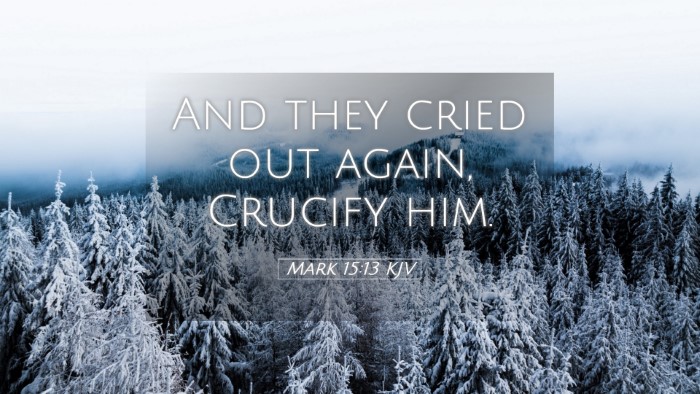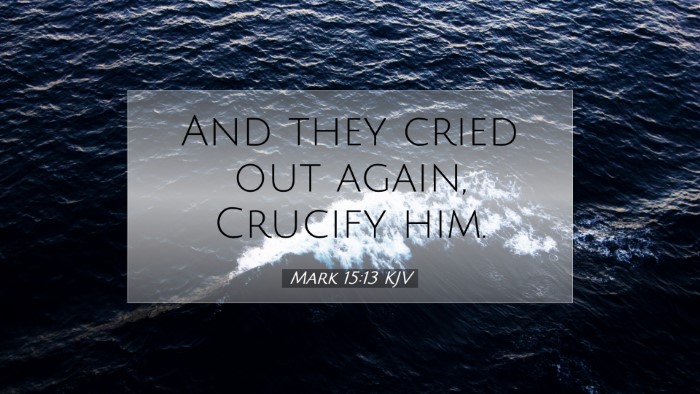Bible Commentary on Mark 15:13
Bible Verse: Mark 15:13 - "And they cried out again, Crucify him."
Context and Background
This verse comes from the heart of the Passion narrative where Jesus stands trial before Pilate. The crowd's demand for crucifixion reflects the culmination of their hostility toward Jesus. Matthew Henry, in his commentary, emphasizes that the vehement call for crucifixion highlights the spiritual blindness of the people, who could not see the true character of Jesus as the Messiah.
Albert Barnes notes that the choice of Barabbas over Jesus symbolizes a tragic rejection of good for the sake of evil. This choice indicates a preference for a known criminal over the innocent Lamb of God.
Adam Clarke points out that the insistence of the crowd is reminiscent of the vehemence demonstrated in mob behavior; when emotions run high, reason often departs. This cry, "Crucify him!", encapsulates humanity's violent tendencies and the rejection of God's grace.
Theological Significance
The demand for Jesus' crucifixion carries profound theological implications. Matthew Henry suggests that this moment signifies the fulfillment of Old Testament prophecies concerning the suffering servant. The prophetic writings anticipated a Messiah who would be rejected and suffer for the sins of the people.
Barnes explains that this act of crucifying Jesus was not just a historical event but a cosmic battle between good and evil. It highlights the depths of human depravity as the very people who should have recognized their Savior opted to eliminate Him instead.
Clarke argues that the crowd's call for crucifixion reveals the heart of sinful humanity—an inclination to reject righteousness and choose wrath. This provides an essential lesson for believers about the tendency to forsake truth for comfort or familiarity.
Lessons for Believers
This verse and its surrounding context offer critical insights for pastors and theologians regarding the nature of human sinfulness. Henry points out that the historical rejection of Jesus serves as a cautionary tale for the church today: to hold firm to the truth and not be swayed by public opinion.
- Spiritual Blindness: Just like the crowd, believers today must be vigilant against falling into spiritual blindness. It is vital to seek God's wisdom and discernment.
- Emotional Responses: The emotional appeal of the crowd demonstrates how feelings can lead to rash decisions. Clarke reminds us to temper our emotions with the truth of God's Word.
- Rejection of Christ: The verse highlights the reality of Christ's rejection. Barnes urges believers to consider how often Jesus is still rejected in society today, and even within churches.
Application for Ministry
For pastors and church leaders, Mark 15:13 serves as a reminder of the challenges faced in ministry. The rejection of Jesus is a current reality, as some congregants may prefer comfort over conviction.
Henry advises ministers to remain faithful in preaching the gospel, even when there is pushback or indifference. He emphasizes the need for courage to declare the truth in love, regardless of the prevailing cultural attitudes.
Barnes echoes this sentiment, stating that the orthodox message of the gospel must be championed, even in the face of popular opinion which may lean toward what is palatable rather than what is profound.
Clarke warns against the temptation to compromise the message for broader acceptance. Building a church based on the whims of the crowd rather than the truth of Scripture leads to spiritual decay.
Conclusion
Mark 15:13 is a powerful testament to the depravity of human nature and the ongoing need for redemption through Christ. The fervent cry of the crowd serves as a reminder that the rejection of Jesus was not an isolated event but a reflection of the human condition and its rebellion against God.
In studying this verse, believers are encouraged to reflect on their relationship with Christ. Are there areas in their lives where they might be crying out "crucify" through their actions or choices? Engaging with this text meaningfully can lead to deeper repentance, a renewed commitment to Christ, and a fervent desire to share the good news with a world that still echoes that ancient cry.


